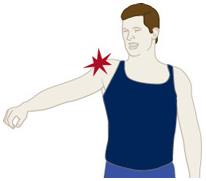SLAP Repair Animation
SLAP Repair
Learn about SLAP Repair
This arthroscopic procedure is performed to repair a tear of the biceps tendon at the point where it connects to the labrum, a ring of cartilage that surrounds the shoulder socket. A tear at this point is called a SLAP (Superior Labrum Anterior-Posterior) tear. SLAP repair is performed under general and regional anesthesia, and patients usually leave the hospital the same day.
This condition is a tear of the labrum in the shoulder joint. The labrum is a ring of cartilage around the shoulder socket that stabilizes the head of the humerus. A SLAP tear occurs at the point where the biceps tendon attaches to the labrum at the top of the socket.
A SLAP tear actually is an acronym that stands for “Superior Labrum Anterior and Posterior.” This condition was first named in 1990.
SLAP tears can result from injury, including: a fall on an outstretched hand, a shoulder dislocation, a sudden jerking of the arm, throwing, or a motor vehicle accident where the shoulder rolls around the seatbelt. SLAP tears can also occur with repetitive overhead activity. SLAP tears are associated with the normal aging process in people over 40.
Symptoms of SLAP Repair
Learn about the Symptoms for Slap Repair
 Symptoms may appear suddenly or over time. Symptoms may include pain in the front of the shoulder, popping and clicking, and reduced function. Speed and strength with throwing, serving, swimming, or lifting may be diminished.
Symptoms may appear suddenly or over time. Symptoms may include pain in the front of the shoulder, popping and clicking, and reduced function. Speed and strength with throwing, serving, swimming, or lifting may be diminished.
An MRI can help with the diagnosis of a SLAP tear, as can the physical exam.
Treatment initially consists of rest, anti-inflammatory medication, stretching (especially shoulder internal rotation), and strengthening.
One of the methods of surgical treatment of a SLAP lesion involves the arthroscopic reattachment of the biceps back to where it belongs at the top of the socket, especially in those patients 40 and under.
This procedure is performed in an outpatient surgery center. The patient usually goes home the same day.
A sling is utilized postoperatively for about three weeks. Physical therapy plays an important role in the recovery process.
Treatment of SLAP Repair
Learn about the treatment of SLAP Repair
Non-steroidal anti-inflammatory medication. Drugs like ibuprofen and naproxen reduce pain and swelling.
Physical therapy. Specific exercises will restore movement and strengthen your shoulder.
Flexibility and range-of-motion exercises will include stretching the shoulder capsule, which is the strong connective tissue that surrounds the joint. Exercises to strengthen the muscles that support your shoulder can relieve pain and prevent further injury. This exercise program can be continued anywhere from 3 to 6 months, and usually involves working with a qualified physical therapist.
Your doctor may recommend surgery if your pain does not improve with nonsurgical methods.
Arthroscopy. The surgical technique most commonly used for repairing a SLAP injury is arthroscopy. During arthroscopy, your surgeon inserts a small camera, called an arthroscope, into your shoulder joint. The camera displays pictures on a television screen, and your surgeon uses these images to guide miniature surgical instruments.
Because the arthroscope and surgical instruments are thin, your surgeon can use very small incisions (cuts), rather than the larger incision needed for standard, open surgery.
Click on shoulder conditions to learn more!
Omaha Shoulder Information provided by Dr. Darren Keiser
